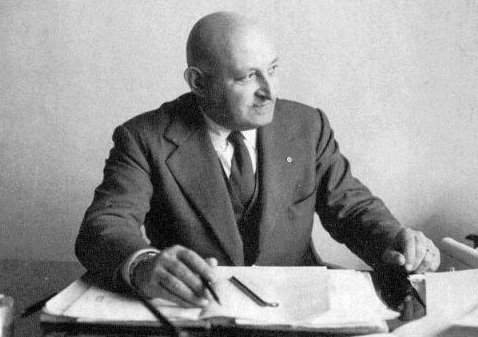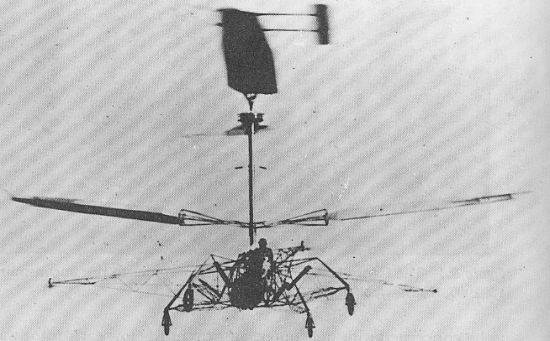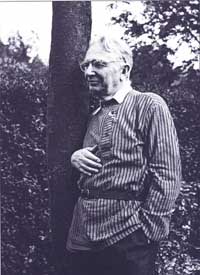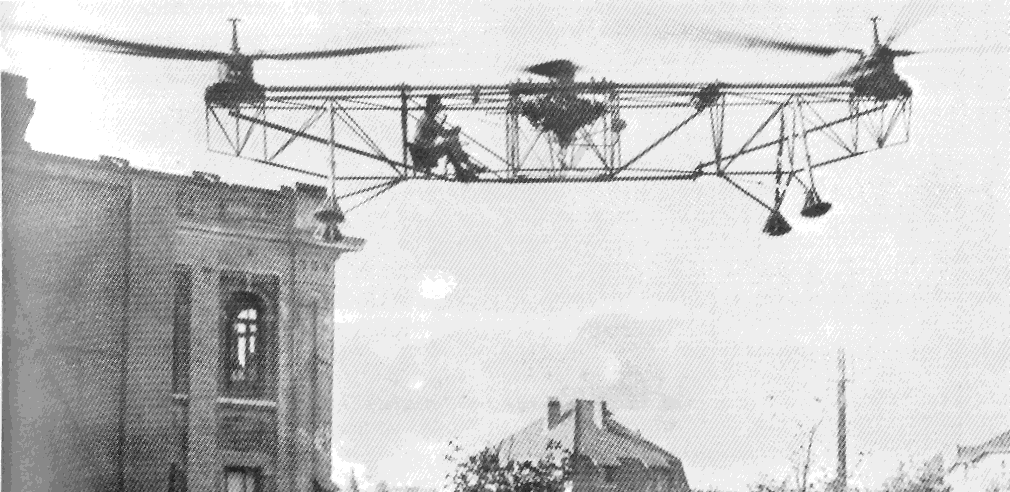<Back to Index>
- Aeronautical Engineer Corradino D'Ascanio, 1891
- Aviation Pioneer Nicolas Florine, 1891
PAGE SPONSOR

General Corradino D'Ascanio (Popoli, Pescara, February 1, 1891 — Pisa, August 6, 1981) was an Italian aeronautical engineer. D'Ascanio designed the first production helicopter, for Agusta, and designed the first motor scooter for Ferdinando Innocenti. After the two fell out, D'Ascanio helped Enrico Piaggio produce the original Vespa.
D'Ascanio had an early passion for flight and design: by the age of fifteen, after studying flying techniques and the ratio between weight and wingspan of some birds, he built an experimental glider which he would launch from the hills near his home town.
After graduating in 1914 in mechanical engineering at the Politecnico di Torino, he enlisted in the voluntary division of the Italian Army entitled "weapon of Engineers, Division Battalion Aviatori" in Piedmont, where he was assigned the testing of airplane engines. Appointed sub-lieutenant on March 21, 1915, D'Ascanio was sent to France to choose a rotary engine to be produced in Italy for the Corpo Aeronautico Militare, returning with an agreement to produce the Gnome et Rhône designed Le Rhône.
After a brief pilot training course in Corsica on a Farman MF.7, he returned to engineering, designing a patented forward facing monitoring device to improve maintenance monitoring within flight squadrons (estimated to have saved fifty lives), and took part in the trials of the first radio equipment installed in Italian aircraft.
In 1916 D'Ascanio was assigned to join Fabbrica Aeroplani Ing. O. Pomilio,
engaged in the manufacture of equipment SP2, Type C, D Type and others.
Following the end of World War I, the Pomilio brothers sold the company
and moved in 1918 with key staff, including D'Ascanio, to Indianapolis in the United States to form the Pomilio Brothers Corporation.
On his return to Italy after a year in 1919, D'Ascanio again settled in Popoli, focused on the control mechanisms for helicopters, through which he derived a number of patents. In 1925 he founded a company with Baron Pietro Trojani, which commissioned by the Ministry dell' Aeronautica produced in 1930 its third prototype, the coaxial D'AT3. This relatively large machine had two double bladed, counter - rotating rotors, with control achieved by using auxiliary wings or servo-tabs on the trailing edges of the blades, a concept that was later adopted by other helicopter designers, including Bleeker and Kaman. Three small propellers mounted on the airframe were used for additional control of pitch, roll and yaw. Piloted by Marinello Nelli in October 1930 at Ciampino Airport, this machine held modest Fédération Aéronautique Internationale speed and altitude records for the time, including altitude (18 m), duration (8 minutes 45 seconds) and distance flown (1,078 m).
However, during the Depression, in which the fascist government of Benito Mussolini concentrated on "standard" production items, the company collapsed in 1932, and D'Ascanio went to work for Enrico Piaggio at his fathers company, designing numerous successful high speed adjustable pitch propellors for Piaggio Aero. His work was considered so important during World War II , he was promoted to General in the Regia Aeronautica, and restarted helicopter development under instruction from President of Piaggio S. p. A. Enrico Piaggio from 1942.
Like many Italians, D'Ascanio found himself unemployed - the Piaggio factory was destroyed through Allied bombing. Worse still, Italy was under an agreement not to research or produce military or aerospace technology for a ten year period, and so he was unemployable in Italy. Approached by pre-war tubing manufacturer Ferdinando Innocenti, who saw the future of cheap private transport and decided to produce a motor scooter – competing on cost and weather protection against the ubiquitous motorcycle.
The main stimulus for the design style of the proposed Lambretta dated
back to Pre-WWII Cushman scooters made in Nebraska, USA. These olive
green scooters were produced in Italy in large numbers, ordered
originally by the US Government as field transport for the Paratroops
and Marines. The US military had used them to get around Nazi
defense tactics, destroying roads and bridges during the Battle of
Monte Cassino and in the Dolomites and the Austrian border areas.
Ferdinando Innocenti gave D'Ascanio the job of designing a simple, robust and affordable vehicle. The vehicle had to be easy to drive for both men and women, be able to carry a passenger, and not get its driver's clothes dirty. D'Ascanio, who hated motorcycles, designed a revolutionary vehicle. It was built on a spar frame with a handlebar gear change, and the engine mounted directly on to the rear wheel. The front protection "shield" kept the rider dry and clean in comparison to the open front end on motorcycles. The pass through leg area design was geared towards all user groups, including women, whose skirts made riding a motorcycle a challenge. The front fork, like an aircraft's landing gear, allowed for easy wheel changing. The internal mesh transmission eliminated the standard motorcycle chain, a source of oil, dirt, and aesthetic misery. This basic design allowed a series of features to be deployed on the frame, which would later allow quick development of new models.
However, D'Ascanio fell out with Innocenti, who wanted to produce his
frame from rolled tubing, rather than a stamped spar frame, thereby
allowing him to revive both parts of his pre-war company. General
D'Ascanio dissociated himself from Innocenti, and took his design
directly to Enrico Piaggio, who produced the spar framed Vespa from 1946.
Innocenti, faced by design problems and production issues surrounding
his tube frame, produced the Lambretta from 1947. In the decades of its
history, the Vespa scooter has become one of the most famous brand
designs worldwide, with 16 million units produced in 130 different
models as of 2005.
In 1948 D'Ascanio attended an international congress for the helicopter in Philadelphia, where he was hailed as a true pioneer. He continued to work for Piaggio, tweaking designs for the Piaggio PD 3, and in 1952 the Piaggio PD4. However, restricted legally through neutrality agreements and financially through reconstruction, Piaggio had by now fallen behind the developments of the American Sikorsky Aircraft Corporation, and few of D'Ascanio helicopter designs or aeronautical developments made it beyond the drawing board.
In 1964 D'Ascanio left Piaggio to join the Agusta Group of Cascina Costa, by then the largest Italian manufacturer of helicopters. In 1969 D'Ascanio designed a small training helicopter, the Agusta ADA, which could be modified for agricultural use - but it was not developed, due to Agusta's commitment to re-equipping the Italian military.
Author of numerous scientific publications, published between 1954 and 1980, he was professor of design of machines and projects at the University of Pisa between 1937 (when he was an employee of Piaggio) and 1961. D'Ascanio, for his services to Italy and aeronautical development, was decorated with the Order of Merit of the Italian Republic by the President of the Italian Republic.
Always disappointed by the fact he was publicly recognized for his
associations with the Vespa motor scooter over his developments and
patents in the world of aviation, D'Ascanio died in Pisa on August 6, 1981.


Nicolas Florine, born Nikolaj Anatoljevitsj Florin (Николай Анатольевич Флорин, July 19,1891, Batumi - January 21, 1972, Brussels) was a Georgia born Belgian researcher, pioneer of aviation who specialized in the study and the flight of helicopters.
Born in Batumi, in Georgia, Nicolas Florine spent his childhood and youth in St. Petersburg, where his parents had emigrated in the early 20th century and studied mathematics at the university. He completed his military service in 1914. After the advent of the Bolshevik Revolution of 1917, Florine took refuge in Germany before returning to the Soviet Union. His family belonged to the bourgeoisie and so he was persecuted by the Communists, but he managed to escape to Finland and thento Belgium in 1920.
Nicolas Florine worked in the Administration of Aeronautics, based in the buildings of the Mint at St. Gilles. In 1926, he was responsible for founding the aerodynamic center whose first director was Professor Emile Allard, located in Rhode - Saint - Genesis, on the outskirts of Brussels. Today, the center has been renamed "von Karman Institute for Fluid Dynamics".
From 1927 , the SNETA (National Society for the Study of air transport) financially supported the work on rotary wing. Nicolas Florine built a helicopter with two rotors in tandem, turning in the same direction. To balance the reaction torque, it skewed the axes of rotation of the rotorsby ten degrees relative to the other. After the implementation of models, including one of 36 kg, which left the ground several times, he built the first device (the "Type I") capable of carrying a driver, powered by a water - cooled Hispano - Suiza 180 hp motor.
Pioneer gives the following description:
"The motor shaft was horizontal, and in place of the propeller hub, was mounted a cardan coupling between the motor and the clutch, the latter was friction multiple - disk and spring. A first bevel gear, bevel and a vertical shaft amount followed the clutch. At the upper end of the vertical shaft was fixed a cooling fan blowing on the water radiator disposed immediately below. At the same height as the radiator, was a second angle to bevel gears that transmitted the rotation of the vertical shaft with horizontal shafts, they drove to the propeller hubs. "
This unit, after being completed by the end of 1929, was partially destroyed in 1930 during a static test after a break of mechanical transmissions.
In 1931 , a second aircraft, lighter and called "Type II", was built. It had a motor Fox of 240 hp air - cooled at its center, and its axis was vertical. Like its predecessor, the Type II had two rotors in tandem (one front and one rear) rotating in the same direction. To balance the reaction torque, it tilted laterally (to the left one the other to the right) the axes of rotation of the rotors about 7° on both sides of the longitudinal axis of the fuselage. Its chassis, welded steel tubes, could support a total weight in working order of 950 kg, or 60% of the weight of the fuselage of the wooden Type I. The device was equipped with flares of magnesium alloy as a landing gear. Flights began on April 12, 1933 and on October 25 of that year, near the beech forest at Sonian the aircraft flown by Robert Collin, Technical Service Engineer at the Aerospace Belgium, unofficially beat the record flight time by flying for 9 min 58 s. A few months later, the team attempted to break the record altitude of 18 meters made in Rome by the machine built by D'Ascanio. During the attempt, the malfunction of a clutch of the transmission resulted in loss of equilibrium and a crash. Very well protected, Robert Collin got away without a scratch. The Florine II had over thirty test flights between April 1933 and May 1934.
A third model was then built, twin-engine this time. The fuselage was reduced when both Salmson engines of 60 hp were placed in front of both sides of the fuselage. The rotor blades were folded at rest. The first flight was performed by Collin on September 15, 1936 and testing was conducted unsatisfactorily until fall 1937.
But the beginnings of the war, with the costs of rearmament Florine run into difficulties. Robert Collin traveled in 1938 to the Belgian Congo to work in civil engineering until his retirement in 1967. As for Florine, he worked on a draft quadrotor until 1949 and remained attached to the STAE until his retirement in 1956. He died in Brussels in 1972, at 81 years.
Nicolas Florine is also known to have devised a system of three filters for the superposition of colored images. These findings were also developed in the 1930s for films.
The Space section of the Air and Space Museum of the Royal Army and Military History in Brussels has documents (photos, plans, drawings. etc.) and a complete wind tunnel model (scale 1/5) used in Project Florine IV, the quadrotor.
